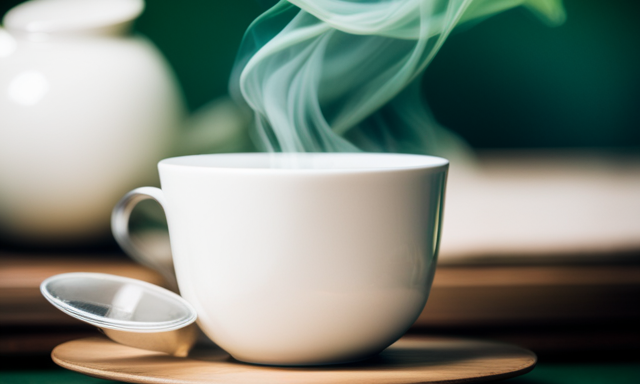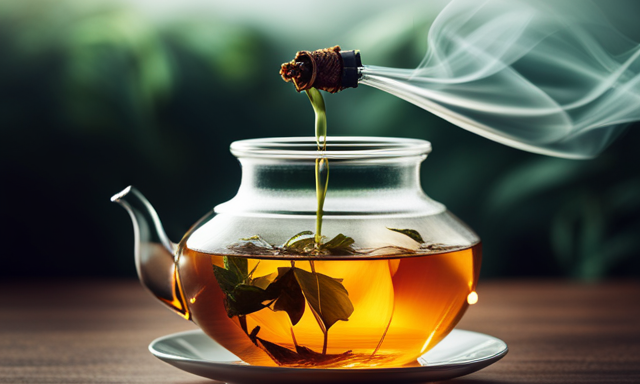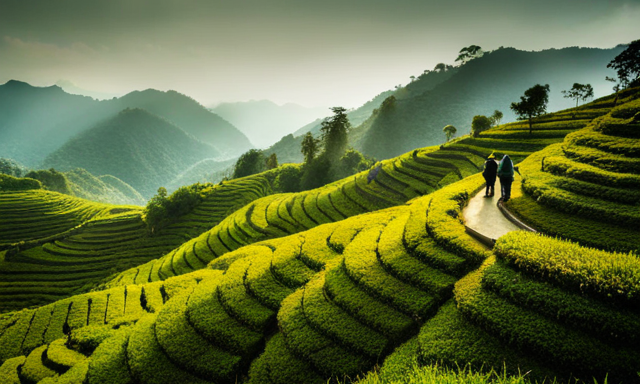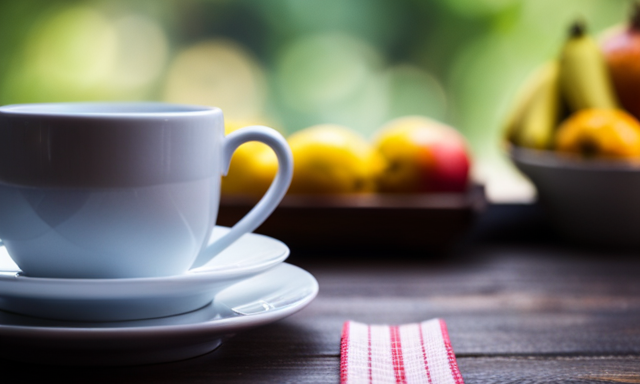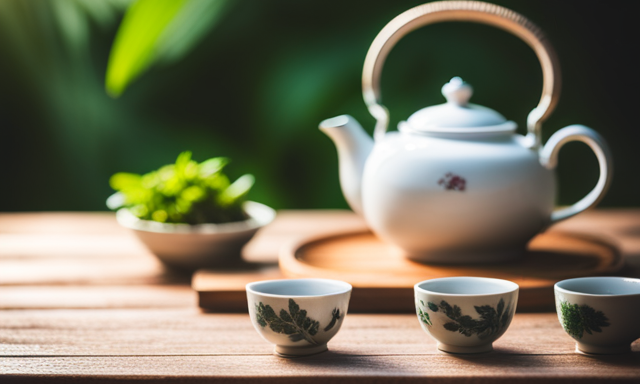As I hold a cup of oolong tea in my hands, its appearance captivates me. Like a golden sunset, the leaves unfurl, revealing their intricate shapes and vibrant colors. The rich aroma dances through the air, enticing my senses.
Oolong tea, with its unique visual presentation, is a work of art in itself. The leaves, carefully plucked and processed, showcase their beauty through their size and shape. From tightly rolled balls to long twisted strands, each leaf tells a story of craftsmanship and skill.
When brewed, the tea exudes a warm amber hue, inviting me to take a sip. Its clarity, like a crystal-clear stream, promises a pure and refreshing taste. Oolong tea is not just a beverage; it is a visual feast, a sensory experience that transports me to a world of flavor and elegance.
Join me as we explore the captivating appearance of oolong tea and unravel its secrets.
Key Takeaways
- Oolong tea has a mesmerizing clarity and golden hue, resembling crystal clear mountain spring water and radiant sunset skies.
- The texture of oolong tea leaves varies from tightly rolled balls to long, twisted strands, which unfurl during the brewing process, creating a visually appealing spectacle.
- Oolong tea offers various health benefits, including a high concentration of antioxidants and polyphenols, boosting metabolism, promoting heart health, aiding digestion, and supporting overall well-being.
- The brewing process of oolong tea involves careful and precise brewing, resulting in the unfurling of tea leaves and the release of delicate flavors, reflecting the quality of the tea leaves.
The Leaves of Oolong Tea
The leaves of oolong tea have a mesmerizing and captivating appearance, enticing tea enthusiasts with their vibrant colors and delicate yet intricate shapes. Oolong tea leaves come in a variety of color variations, ranging from bright green to dark brown. These color variations are a result of the different processing techniques used in the production of oolong tea.
The leaves are carefully plucked from the tea plant and then withered in the sun, which helps to remove excess moisture. After withering, the leaves are then rolled and twisted by hand or with machines, which further releases their natural oils and flavors. Finally, the leaves are fired or roasted to stop the oxidation process. This careful and intricate process gives oolong tea its unique and distinct flavors.
Moving on to the color of oolong tea, it is an important aspect that complements its appearance and adds to the overall sensory experience.
The Color of Oolong Tea
With a hue reminiscent of a golden sunset, oolong tea exhibits an enchanting blend of warm and earthy tones. The shade of oolong tea can vary, ranging from a light amber to a rich mahogany. To help you visualize the color, imagine a table with three columns and three rows. In the first column, picture a field of golden wheat swaying in the breeze. In the second column, envision the deep, rich brown of freshly turned soil. Finally, in the third column, imagine the warm, glowing tones of a sunset over a calm ocean. These colors come together to create the unique shade of oolong tea. As we explore further, we will discover the delightful aroma that accompanies this captivating tea.
The Aroma of Oolong Tea
Imagine the moment you first breathe in the irresistible scent of oolong tea, as it transports you to a tranquil oasis of aromatic bliss. Oolong tea possesses a unique and captivating aroma profile that sets it apart from other teas.
The fragrance is often described as floral, with notes of orchid, jasmine, and osmanthus. This delightful aroma is a result of the intricate brewing techniques used to prepare oolong tea. The leaves are carefully picked, withered, and partially oxidized, allowing the tea to develop its distinct fragrance.
The brewing process further enhances the aroma, as the tea leaves unfurl and release their fragrant oils. With each sip, the exquisite scent lingers on your palate, leaving a lasting impression.
As we move into the next section about the shape of oolong tea leaves, we begin to explore the fascinating aspects of this remarkable tea.
The Shape of Oolong Tea Leaves
As you hold a cup of freshly brewed oolong in your hands, the curled, twisted leaves unfurl, revealing their intricate shapes and colors, reminiscent of delicate bonsai trees in a serene garden. The shape of oolong tea leaves is unique and fascinating.
They can range from tightly rolled balls to long, wiry strands. Some leaves may have a twisted appearance, while others are more elongated. The colors of the leaves can vary as well, from vibrant greens to deep browns.
When brewed, oolong tea has a beautiful amber color, with the leaves floating gracefully in the liquid. The appearance of brewed oolong tea is captivating, with the unfurled leaves adding an element of elegance to the drink.
Transitioning into the subsequent section about ‘the size of oolong tea leaves’, one can’t help but wonder about the dimensions of these remarkable leaves.
The Size of Oolong Tea Leaves
The size of oolong tea leaves can vary widely, from petite and delicate to long and slender. This variation is due to the harvesting process, where leaves are plucked at different stages of growth. Younger leaves, known as ‘two leaves and a bud,’ are smaller and more tender, while older leaves are larger and more mature.
The size of the leaves also depends on the specific oolong tea variety being produced. For example, Tie Guan Yin oolong tea has smaller leaves, while Da Hong Pao oolong tea has larger leaves. The size of the leaves can have an impact on the flavor and aroma of the tea. Smaller leaves tend to produce a more delicate and nuanced taste.
Overall, the size of oolong tea leaves is an important factor in the production and enjoyment of this unique type of tea.
The Texture of Oolong Tea Leaves
You may be surprised by the velvety smoothness and delicate texture of oolong tea leaves as they unfurl in your hands. The leaves are not only visually appealing but also have a unique feel to them. Here is a closer look at the texture of oolong tea leaves:
-
Soft and supple: Oolong tea leaves have a soft and supple texture, almost like touching a silk fabric. They are pliable and gentle to the touch, making them easy to handle.
-
Fine and intricate: The leaves are finely rolled, creating intricate patterns that add to their visual appeal. Running your fingers over the leaves reveals their intricate texture, like tiny waves rippling across the surface.
-
Vibrant green hues: Oolong tea leaves come in various shades of green, ranging from light and vibrant to deep and rich. The color is a reflection of the tea’s quality and freshness.
-
Aromatic essence: As you handle the leaves, you’ll notice a subtle, yet captivating aroma. The fragrance is reminiscent of freshly cut grass and floral notes, hinting at the delightful flavors that await when brewed.
As the oolong tea leaves unfurl, their texture gives way to the appearance of brewed oolong tea, revealing a whole new sensory experience.
The Appearance of Brewed Oolong Tea
Get ready to feast your eyes on the mesmerizing transformation that happens when you steep oolong tea leaves and witness the captivating appearance of the brewed infusion. The color, aroma, and clarity of brewed oolong tea are influenced by various factors, including the temperature at which it is brewed and the brewing time. To achieve the perfect balance, it is recommended to brew oolong tea at a temperature of around 185°F (85°C) for about 3-5 minutes. This allows the leaves to unfurl gracefully, releasing their delicate flavors and enticing fragrance. The resulting brew showcases a beautiful amber hue, ranging from light golden to deep amber, depending on the specific type of oolong tea. The clarity of the infusion adds to its visual appeal, making it a treat for both the eyes and the palate. As we delve into the next section about the color of brewed oolong tea, we will explore its fascinating variations further.
The Color of Brewed Oolong Tea
When brewed, oolong tea exhibits a beautiful range of hues, which can vary depending on the specific type and processing method. The color can range from a light golden yellow to a deep amber or reddish-brown. The temperature at which the tea is brewed can also affect its color, with cooler temperatures resulting in a lighter color and hotter temperatures producing a darker shade.
Brewed oolong tea is not only visually appealing but also offers numerous health benefits. It contains antioxidants that can help protect against cell damage and improve overall well-being. Oolong tea is also known to boost metabolism, aid in weight management, improve digestion, and promote heart health. Sipping a cup of brewed oolong tea can be a delightful and nutritious experience.
Now, let’s move on to discussing the clarity of brewed oolong tea without missing a beat.
The Clarity of Brewed Oolong Tea
Indulging in a cup of freshly brewed oolong tea reveals a mesmerizing clarity that rivals the crystal clear waters of a pristine mountain spring. The clarity of brewed oolong tea is truly remarkable, with its golden hue shining through the transparent liquid.
As the tea leaves unfurl and release their delicate flavors, the brew becomes a sight to behold. This clarity is a testament to the quality of the tea leaves and the careful brewing process. Not only does the clarity enhance the visual appeal, but it also signifies the health benefits that oolong tea offers. With its high concentration of antioxidants and polyphenols, oolong tea is known to boost metabolism, promote heart health, and aid in digestion.
Transitioning into the subsequent section about the visual presentation of oolong tea, it is important to note that the clarity is just the beginning of its captivating allure.
The Visual Presentation of Oolong Tea
The visual presentation of oolong tea is simply breathtaking. Its shimmering golden hue and ethereal transparency captivate the senses. When brewed, oolong tea showcases a stunning visual display. The appearance of brewed oolong tea is characterized by its radiant amber color, reminiscent of sunset skies. The liquid is clear and bright, allowing the light to pass through, revealing the intricate details of the tea leaves suspended within.
The texture of oolong tea leaves can vary, ranging from tightly rolled balls to long, twisted strands. These leaves unfurl during the brewing process, revealing their vibrant shades of green and brown. As the tea steeps, the leaves dance and swirl, creating a mesmerizing spectacle that adds to the overall visual appeal of oolong tea.
Frequently Asked Questions
How does the taste of oolong tea differ from other types of tea?
Oolong tea has a unique flavor profile that sets it apart from other types of tea. It undergoes partial oxidation, giving it a complex taste that falls between the freshness of green tea and the deep richness of black tea.
Can oolong tea be brewed using a teabag or is it better to use loose leaves?
When it comes to brewing oolong tea, both teabags and loose leaves can be used. However, using loose leaves allows for better flavor extraction and a more authentic experience, while teabags offer convenience and ease of use.
Does oolong tea contain caffeine?
Yes, oolong tea does contain caffeine. However, it also has antioxidants which can provide various health benefits. With its rich flavor and moderate caffeine content, oolong tea makes for a good alternative to coffee.
What is the best temperature and steeping time for brewing oolong tea?
The best brewing technique for oolong tea involves steeping it at a temperature of 190-205°F for 3-5 minutes. This allows the flavors to fully develop, resulting in a rich and complex taste profile.
Are there any health benefits associated with drinking oolong tea?
Drinking oolong tea can offer numerous health benefits, including aiding weight loss. This delightful brew boosts metabolism and helps burn fat, making it a tasty and effective addition to any healthy lifestyle.
Conclusion
In conclusion, oolong tea is a visually stunning beverage that captivates the senses. The leaves of oolong tea are distinctive, with a beautiful mix of colors ranging from dark green to reddish-brown.
The aroma of oolong tea is fragrant and enticing, while the shape and size of the leaves add to its charm.
When brewed, oolong tea exhibits a rich, amber color and a remarkable clarity.
One interesting statistic to note is that oolong tea is known for its unique visual presentation, making it a treat for both the eyes and the taste buds.

